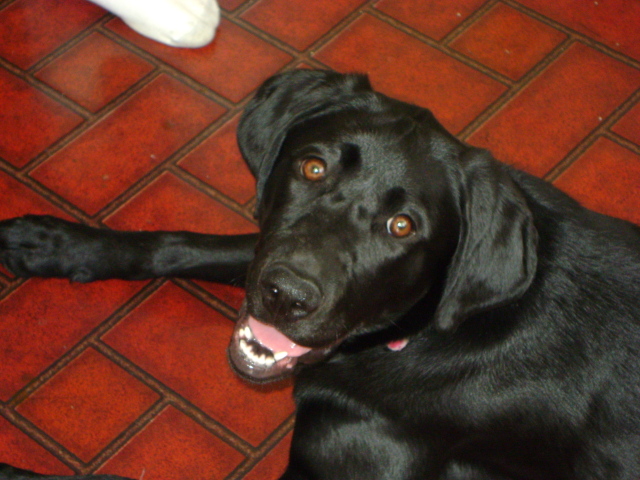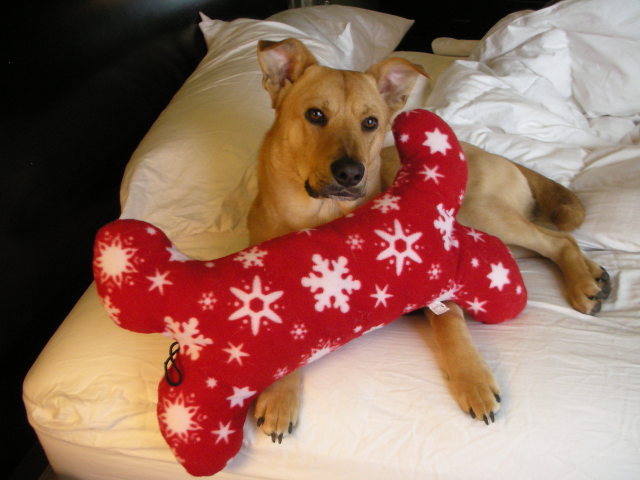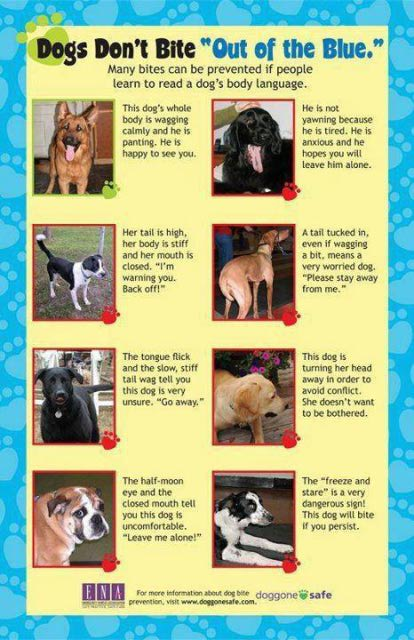QuestionQUESTION: I have a 3 1/2 yr. old neutered male hound mixed breed named Billy. He always seemed to be a bit "shy", over the last few months he has gotten agressive towards strangers, and has actually snapped at 2 people. We adopted a 1yr. old bluetick mix neutered female about 10 months ago...there haven't been any problems, and they get along fine. We also have our 4 yr. old granddaughter stay with us one day a week...I am wondering if he hasn't developed some sort of protective behavior??? Billy came to us from a rescue when he was about 7-8 months old. He always has been timid, but never acted out, and as soon as he warmed up to someone, was fine. He is wonderful with our granddaughter, and tolerates her play.
ANSWER: Billy is a fear biter. Unfortunately, his behavior is escalating. A "snap" is the first stage of active aggression. Please describe who he snapped at, under what circumstances, what sex these people were, why they were in your home, how you reacted when these situations arose, how you have attempted to help Billy accept 'strangers' in your home, etc. And be aware that no expert anywhere can fully evaluate your dog without hands on, observation, and full interview of every human in the household. Aggression toward a human is the most unacceptable behavior in the domestic dog and requires expert rehabilitation. Give a more detailed explanation of Billy's behavior and I will attempt to help you prevent if from worsening; but you need to find a certified applied animal behaviorist (NOT a dog trainer!) The veterinary college in your geographical area should be able to refer you to a professional. Be certain this person is experienced with, and comfortable treating, active fear aggression.
---------- FOLLOW-UP ----------
QUESTION: In the 3 yrs. we have had him, we sort of just let him loose, and he seemed to just go up to whomever, and very quickly relaxes and was fine, We live in a pretty rural area, and he is pretty much loose, does not wander, is close to home , and VERY obedient. BUT over the last month on 2 ocassions we had someone drop by, 1 male, 1 female, and he darted out of the house barking ( which is his normal MO ) although on these 2 occasions he actually went right up to them and tried to nip them...in the past he would just bark and kind of dance around them...then make friends. Do you think there maybe a medical issue, or that he has become protective of the new dog, she has been here almost a year...and like I said, it's only been within the past 4 weeks! In our home it is just my husband and I, we don't have a lot of company...we walk the dogs daily, and might stop and chat w/ a neighbor, but the dogs aren't very socialized. Our grand daughter (4 yr ) with us 1 day a week, and Billy is wonderful with her...always has been. My thought was maybe to either try to socialize him w/ other people, either dog walking with friends, or do a local dog obedience class. I work at a veterinary clinic ( although equine ) have a lot of exposure to other pet owners, and do have a contact w/ the local Homeward bound rescue, where we got Gracie ( our female mix ) from, and I'm pretty sure they could steer me in the right direction w/ whatever you suggest....He really is a sweet dog, and this seems so out of character....THANK you for your input, and any advise you might give. ann
AnswerSomething about that first visitor might have set him off and he then took that behavior to the second visitor. For instance: dog runs toward first visitor (let's call him A), dog barks and/or exhibits a behavior that troubles A, A backs off, showing fear, dog reacts to the fear and escalates his vigilance. Now, second visitor(B) approaches, dog is now more anxious than he was before A, exhibits a tad over the top more vigilance than before A, B also reacts by backing off (or other displays of fear, adrenaline rush is sufficient, dog can smell the adrenaline). End result: dog is now more anxious about 'strangers' and will likely escalate (meaning, actually bite.) You need to do some serious work with this dog BEFORE ALLOWING him to continue loose on your property. You seem to have wonderful resources (the rescue group, the veterinary clinic, etc.) but what you must be VERY CAREFUL of is some dog trainer (who thinks s/he understands what's going on) who might steer you toward aversive techniques to control Billy (like choker collar, e collar, training involving any coercion which will quickly spread to generalize all the people in the class, especially the approaching trainer.) Be SURE you find a class where the person in charge does NOT use outdated, abusive training techniques and where people in the class are prepared for an overtly fear aggressive dog. You might be better off handling this situation in social interactions.
Billy is only at the very beginning of this aggression. Walking him with people you have recruited to set him up (one person at a time) is most likely the best first approach. Instruct the volunteer (V) to totally IGNORE whatever behavior Billy offers. Put Billy on strong long training lead. Stand with him casually in an unfamiliar place (not your property); ask V to approach casually. When Billy goes toward V (barking and whatever other behavior he will demonstrate), V is to stand still with NO reaction visible (ask V to have Tic Tacs and be eating one during this meeting, that will mask V's adrenaline.) YOU will then go to the end of the long leash in the opposite direction of Billy so that he is then forced to stop going forward with NO overt correction or "stop" from you. Billy will (eventually, might take a few seconds and this will shorten with each new "V") look TOWARD you. At that point, praise him, walk toward him until the leash is shorter and then approach V. Greet V and carry on a normal conversation, totally ignoring whatever Billy does (unless he goes toward V with aggression, in which case you will repeat going to the end of the leash, etc.) What you are doing is counter conditioning and attempting to desensitize Billy to all your V's. Once you see Billy totally change his attitude toward any approaching V during these exercises, you are ready to take it onto your own property with the same restrictions (on long leash, etc.) Billy might change his behavior within three trials. His behavior on your property might persist for more than that, it's hard to say. The reaction of every single V is very important. NO ONE can demonstrate (or even react internally) fearfully. As soon as Billy shows no vigilance ON your property, you are ready to take him off leash and keep going. Since most of the people who visit you are most likely known to you, sorting through your friends, coworkers, neighbors, relatives, etc. for these exercises should not pose a problem. At first, Billy will persist in his vigilance and aggression, but he should begin to change this behavior with persistent work. OFF leash on YOUR property, he may revert; it's very important that you GO in the OPPOSITE DIRECTION when (and if) he does, then RETURN toward him the MOMENT he stops, and then you will be greeting V and observing Billy to be certain he doesn't revert (if he does, starting over by going away from him.) It's more difficult to instruct this sort of counter conditioning in print, I'd much rather be there to observe. You have to observe Billy's body language closely; you have to withdraw consistently (with NO COMMENT to Billy) when he demonstrates behavior you do not want; V has to be calm and not fearful. Eventually, Billy should be able to go back to his former behavior of barking but then showing a friendly nature. This could happen quickly; I've seen dogs rehabilitate from far worse 'stranger' aggression in one two hour session. If you have any questions, please repost, and DO let me know how it turns out.

 Nightmares?
Question
Beethoven
Hi Melissa, Ive had my very h
Nightmares?
Question
Beethoven
Hi Melissa, Ive had my very h
 Mini Daschund with anxiety issues
QuestionAbigayle
QUESTION: I have a 3 1/2 yr old
Mini Daschund with anxiety issues
QuestionAbigayle
QUESTION: I have a 3 1/2 yr old
 Black lab - 1 yr
QuestionSheba
QUESTION: My lab loves to bite her
Black lab - 1 yr
QuestionSheba
QUESTION: My lab loves to bite her
 Very Scared Dog
Question
Happy
My dog is 17 months old and is a mixed b
Very Scared Dog
Question
Happy
My dog is 17 months old and is a mixed b
 Is this aggression, dominance, or play?
QuestionQUESTION: I have a question regarding doggy beh
Is this aggression, dominance, or play?
QuestionQUESTION: I have a question regarding doggy beh